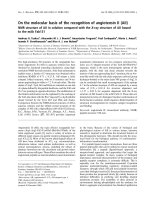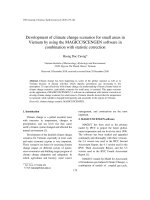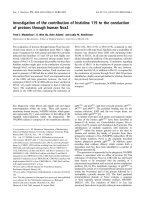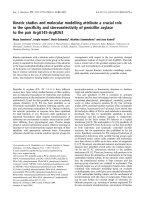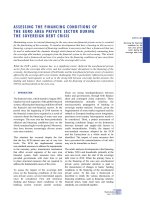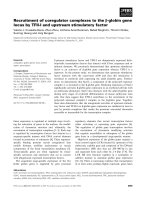Accessibility of private sector to the official development assistance funds for infrastructures development in Vietnam
Bạn đang xem bản rút gọn của tài liệu. Xem và tải ngay bản đầy đủ của tài liệu tại đây (39.24 MB, 83 trang )
V\^^
UNIVERSITY OF ECONOMIC AND BUSINESS - VNU
UPPSALA UNIVERSITY - SWEDEN
.
Vrfrl'^^.^
MASTER PROGRAM IN PUBLIC MANAGEMENT
""I'rL.^,
UNIVERSITET
-^u^^^
MASTER THESIS OF MPPM
Accessibility of private sector to
t/ie
Official
Development Assistance funds for infrastructures
development in Vietnam
Author:
Trirang
Tan Lam
Supervisor:
Dr.
Sven-Erik
Svard
Local Supervisor:
Dr.
Nguyen
Anh Thu
Class:
MPPM
-
Intake
6 -
Group
19
Hanoi,
May 2013
Contents Page 1
CONTENTS
Abbreviations and Acronyms 2
Abstract of Thesis 3
Chapter
J:
Introduction
6
/./. Background 6
1.2
Research Purpose 8
1.3.
Research Questions 9
Chapter 2: Frame of reference 10
2.1.
Definition of Terms 10
2.1.1.
ODAfund
10
2.1.2. Infrastructure 10
2.2.
Past researches on ODA in Vietnam
11
2.3.
Researches on private sector 12
Chapter 3: Methodology
13
3.1.
SWOT model 13
3.2 Contents of analysis 14
Chapter 4: Analys Results 15
4.1.
Situation of management and use of ODA in current public sector
15
4.1.1.
Strengths 15
4.1.2. Weaknesses
15
4.1.3.
Opportunities
T^
4.1.4.
Threats 17
4.2. Private sector access to ODA funds 18
4.2.1.
The first reason
i8
4.2.2. The second reason
^0
4.2.3. The third reason
22
4.2.4. The fourth reason
26
4.2.5. Limitation and challenges
31
4.3.
Solutions for the private sector to approach ODA capital 32
4.3.1.
Current legal conditions
^2
4.3.2. Creating enabling conditions
^^
4.3.3. Creating business opportunities
^-f
4.3.4. Pilot projects
35
Chapter 5: Findings and Conclusions
^^
5.1.
Findings
-"
5.2. Limitations and directions for further research
^8
5.3. Conclusion
-^^
-, .
40
Reference
masier i
nests:
ivuister rrity,ram in r mute Management
Student: Truong Tan Lam
Abbreviations and Acronyms
Page 2
Abbreviations and Acronyms
ODA
OECD
PPP
ADB
WB
FIDIC
JBIC
CIRR
BOT
Official Development Assistance
Organisation for Economic Co-operation and Development
Private - Public Partnerships
Asia Development Bank
World Bank
Federation
Internationale Des Ingenieurs-Conseils
Japan Bank for International Cooperation
Commercial Interest Reference Rates
Build - Operate - Transfer
\fa.ster
Thesis: Master Program in Public Management
Student:
Truong Tan
Lam
Abstract of Thesis
PageJ
Abstract of Thesis
Title:
Accessibility of private sector to the Official Development
Assistance funds for infrastructures development in
Vietnam
Level: Final assignment for Master Program in Public
Management
Author:
Trwong
Tan Lam
Supervisors:
Swedish Supervisor: Dr. Sven-Erik Svard
Local Supervisor: Dr. Nguyen Anh Thu
Date when the thesis is presented: May 18, 2013
Aim:
Shortage of public financial resources for investment and development of
infrastructure is a challenge threatening the development model called
"East
Asian
Miracle".
In that circumstance, this study aims to clarify the benefits of
accessibility of private sector to the Official Development Assistance funds to
invest the infrastructure projects and prove that this is the solutions for the
story of deficiency and wastefulness of public financial resources in current
infrastructure investment in Vietnam.
Method:
The SWOT model is used to analyze the existing situation of ODA
funds management and utilization. The result of SWOT analys will be used
to study on the direction of repairing the weaknesses, mitigating the threats,
developing strengths and salvaging the opportunities. On these basis of the
Ma.ster
Tfiesis:
Master Program in Public Management
Student: Truong Tan Lam
Abstract of
Thesis Paee
4
study to point out the benefits from the accessibility of the private sector to
the ODA funds for infrastructure development projects. The SWOT analysis
is conducted according to the qualitative method of secondary data sources
collected.
Result & Conclusions:
The study demonstrate the from the accessibility of the private sector to
the ODA funds for infrastructure development projects. There are four main
reasons for ODA shift from the public to the private sector found in this study
including: The first reason is to limit the extemal challenge coming from the
development agencies in the trend of these agencies as ODA sponsors which
have strategies focusing direction on the private sector. The second reason is
to prevent the public debt risk of Vietnam beyond the safety threshold. The
third reasons to overcome the weakness of slow progress and slow
disbursement of ODA in the public sector today. The fourth reason is to
overcome the weakness of ODA waste in the public sector as the consequence
of inefficient management and rampant corruption.
Suggestions for future research:
This research has a limitation when the SWOT model has been chosen
to analysis the collected secondary data. This study was only to clarify the
weakness and threats of ODA management in existing public sector that is
not enough data to analyze on the positive aspects as strengths and
opportunities. This limitation opens for further research in the future that is to
select the model from the quantitative analysis of
primarx'
data collected
directly in a number of public sector specific ODA projects that has been
caiTied
out. Based on the method of monitoring and evaluating ODA projects
developed by a number of organizations such as World Bank,
ADB,
JBIC
with the theory Result-based monitoring and evaluating system
b\
Jody
Kusek
and Ray Rist will give a full assessment results more adequately and
Ma.ster Thesis: Master Program in Public Management
Student: Truong Tan Lam
Abstract of Thesis
Page
5
more accurately.
Contribution of the thesis:
This study has shown the benefits from the accessibility of the private
sector to the ODA funds for infrastructure development projects. In the
context of difficulty of public finance resource today, this is a new way to
make a breakthrough and the prospects for infrastructure development in
Vietnam in the future.
Key words:
Infrastructure challenge, ODA, private sector, public sector, efficiency,
deficiency.
Master Thesis: Master Program in Public Management
Student: Truong Tan Lam
Chapter 1: Introduction
p^^Q
g
Chapter 1: Introduction
LL Background
In the past two decades, the vigorously amazing change of economies
from East Asian countries has been recorded, which some scholars call it the
"East Asian Miracle". The motivation that is also the consequence of these
changes is the rapid development of infrastructure. The story of infrastructure
development in East Asia, specifically, the developing countries in this area
made polyhistors and development organizations such as the World Bank, the
Asia
n Development Bank, etc, pay attention on many different aspects related to
infrastructure development.
In the book Connecting East Asia: A New Framework for
Infrastructure]o\n\.\y
published by World Bank, Asia Development Bank and
Japan Bank for International Cooperation in 2005, the infrastructure
development raised as a challenge to East Asia. Among them, the public
finance resources for infrastructure is one of the leading challenges. To meet
the demand of infrastructure
services.
East Asia erea must spend at least 6,2%
of GDP for investment in the critical infrastructure group each year includes
electricity, telecommunications, water supply and environment, sanitation,
primary traffic network. Of these, approximately 65% of budget is for new
investment and 35% for the maintenance the existing systems.
Vietnam, a country located in the dynamic region with the annual
average over 7% of economic growth rate in the past two decades are also
facing difficulties as investment infrastructure needs is beyond the adapting
scope of public financial resources. In recent years, Vietnam has annually
spent an average 10% of GDP for infrastructure de\elopment investment
(Figure 1).
Master Thesis: Master Program in Public Management
Student: Truong Tan Lam
Chapter
I:
Introduction
Page
7
Figure 1. Infrastructure Investment
In
Viet Nam
10
9
8
7 ^
6
5
4
3
H
2
1
0
Blnfrastaicture
Investment (US$
1995 1996 1997 1998 1999 2000 2001 2002 2003 2004 2005 2006 2007
r
14.0%
12.^<)
O
o
10.1^
o
E
8.0^
>
6.0%
2
4.0^
m
2.0^
0.0%
Figure
I:
Infrastructure Investment
in
Vietnam
(source:
General Statistics Office)
The question
is
that
the
investment resource issues,
an
important
aspect
in
overall
of
the infrastructure development
in
East Asia area.
See the
investment finance structure
for
infrastructure
of
Vietnam
(Boxl)
shows
a
very high ratio
(61%) of
investment
flinds
from
the
State budget,
the
government bonds
and
ODA,
in
which ODA funds rate
is
more than one third
of total investment funds
for
infrastructure.
That's
demonstrated that
investment resource depends heavily
on
ODA.
Box
1:
Infrastructure financing
for
Vietnam
in
2002
Total investment
for
infrastructure
in
2002
is US$ 3.3
billion.
In which, 28% from state budget. 14% from
users,
37% from
ODA and private sector financing 28%.
Source: General Statistics Office.
Master Thesis: Master Program
in
Public Management
Student: Truong
Tan Lam
Chapter 1: Introduction
/'age
8
1.2 Research Purpose
There are many studies from local and oversea related on the solutions
of the shortage problem of financial resources for the investment
infrastructure development needs. In general, these studies are discussed in a
general solution is to increase the participation of the private sector. For
Vietnam, the context in which the participation of the private sector is in very
faint role, infrastructure investment finance is mainly depends on ODA funds.
Efficiency and performance in public investment for infrastructure have
so much drawbacks, especially using of ODA funds, an important funds
resource for many poor countries till remained inadequately. I personally
believe that the infrastructure development matter in Vietnam despite own its
characteristics, but also is not outside of rules and the general relationship of
the East Asian issues. And the road for infrastructure development in Vietnam
could not lack the two leveraged factors which contributed to the "East Asian
Miracle" called the private sector and ODA funds. The institutional reform in
investment to maximum exploit the advantages of both the factors, especially,
to facilitate for interaction of two factors will create the important catalytic
and promote the great benefit. In this case, the
goxemment
should consider
the mechanism to allow the private sector to access to ODA funds through
some kinds in which I would like to emphasize the public private partnership
(PPP) for the investment of infrastructure development projects.
Therefore, this study aims to clarify the
anah
sis of the benefits to the
private sector that is able to access to ODA funds
inxestment
in the
infrastructure development projects and to prove that are solutions for the
budget deficiency and resources wasting in current infrastructure investment,
as well as to confirm that these solutions bring good prospects for
infrastructure development in Vietnam.
Master Thesis: Master
Pro};ram
in Public Management
Stuilent:
Truong
Tan Lam
Chapter 1: Introduction Page 9
1.3. Research Questions
For the purpose of above research, the questions posed are:
- Question I: What are the benefits to the private sector accessing
ODA funds to invest infrastructure development projects?
- Question 2: Which measures and proposals were given to the private
sector accessing ODA funds to become realistic and effective?
Master
Tfiesis:
Master Program in Public
ManagetnetU
Student: Truong Tan Lam
Chapter 2: Frame of reference
Page
10
Chapter 2: Frame of reference
2.1.
Definition of Terms
2.LL
ODAfund
ODA is acronyms of Official Development Assistance. According to
definition of Organisation for Economic Co-operation and Development,
''ODA
is flows of official financing administered with the promotion of the
economic development and welfare of developing countries as the main
objective,
and which are concessional in character with a grant element of at
least 25 percent (using a fixed
10
percent rate of discount). By convention,
ODA flows comprise contributions of donor government
agencies,
at all
levels,
to developing countries (bilateral ODA) and to multilateral
institutions. ODA is disbursed from bilateral donors and multilateral
organizations** (OECD, Glossary of Statistical
Terms;
.
According to Vietnamese regulations, ODA comprises non-refundable
aid ODA and loan ODA. Non-refundable aid ODA is a way of ODA
financing without refundment to the donors. Loan ODA is the way of
refundable financing ODA with concessional conditions on interest, grace
period and refundment period assuring a grant element of at least 35 percent
for the tied loans and 25% for the untied loans (Article 5, Decree
38/2013/ND-CP,
issued on April 24, 2013).
2.1.2. Infrastructure
According to definition of Investorwords.com,
''infrastructure
is the
basic phvsical svstems of
a count?y*s
or
community^'s
population,
including
roads,
utilities, water, sewage, etc. These systems are considered essential for
enabling
productivity^
in the economy Developing infrastructure often
Master Thesis: Master Program in Public Management
StudetU:
Truong Tan Lam
Chapter 2: Frame of reference
— •
Page
11
requires large initial investment, but the economies of scale tend to be
significant
"'^.
In Vietnam, The Construction Law issued in 2003 defined the
infrastructure as follows:
"Infrastructure
work system comprise
transportation system, communications, power supply public lighting, water
supply, sewage, disposal treatment and other works ".
In the limit of this paper the term of infrastructure are understood as
infrastructure work system defined in Construction Law
2003.
2.2. Past researches on ODA in Vietnam
From
till
now, there is also a number of researches on ODA in Vietnam
but mostly in terms of research on the relationship between ODA and
economic development in general or economic development in some specific
sectors. Some researches mention to the situation and solutions to effectively
manage ODA by improving the existing public sector. These include a
number of such researches: Research by Ho Huu Tien in 2009, Discussion on
ODA management in
Vietnam,
Bulletin of Science and Technology - Danang
University, N
2(31);
Phan Trung Chinh, Characters of ODA and Situations in
Management of this Fund in
Vietnam,
Bank Bulletin No 7, April
2008;
Tan
Due,
ODA: Effectiveness is still not management target, Economics and
Forecast Bulletin, No.
14/2008.
Those researches focus on analysing situation
and proposing solutions to use ODA more effectively but only limit in
improving method management, training human resources, strengthening
supervision without referring to an important approach which is to increase
the participation of the private sector to impro\e the efficiency of ODA.
The research on ODA in the expertise areas must be listed is the
research by Pham Thu Hien (2007),
777t'
Effects of
ODA
in Infrastructure in
' htlp://www.invcslorwords.com
Master Thesis: Muster Program in Public
Managenicni
Student: Truong Tan Lam
Chapter 2: Frame of reference
Page 12
FDI
Inflows in Provinces in Vietnam 2002
-2004,
Vietnam Development
Forum in Tokyo, The
39^*"
Workshop. This research focuses on the
relationship between ODA in infrastructure to attract FDI, proving that ODA
play an important role in improve infrastructure, workforce and upgrading
local market scope thereby contributing to attracting FDI.
2.3.
Researches on private sector
It is hard to deny that to make
'*East
Asian Miracle" is the participation
of the private sector. Once the demand for infrastructure investment beyond
the response of public financial resources, the role of private sector
participation is very important. The developing countries in East Asia are
getting lots of ODA financing from development agencies, among
contributions are from the two multilateral development agencies of World
Bank and Asian Development Bank. Therefore, this paper also use some
findings about private sector related to ODA financing in the book Private
Sector Development Strategy is published by Asian De\'elopment Bank in
2000 and Private Development Strategy - Directions for the World Bank
Group published by World Bank in 2002. These findings are used to analyse
the ODA financing in Vietnam on the aspect of how efficient when pri\ ate
sector is permitted to access ODA.
Master Thesis: Master
Program
in
Publie
Management
Student: Truong Tan
Lam
Chapter 3:
Methodolo^
Page
13
Chapter 3: Methodology
3.1.
SWOT model
SWOT model is commonly used to analyze, evaluate the situation of
enterprises, help them to define policies for the future. SWOT are acronyms
of Strengths, Weaknesses, Opportunities and Threats. Strengths and
Weaknesses are internal factors of the organization, Opportunities and
Threats is the impact of extemal factors, SWOT analysis is permitted to
analyse the various factors that affect relatively the competitiveness of
enterprises (Figure 3).
In the public sector, SWOT model is commonly used to assess the
internal factors and extemal impact of the public organization, find out the
strengths, weaknesses, opportunities and challenges, thereby improve
situation of the organization.
For qualitative research method based on the collection of secondary
data as in this paper, the application of SWOT to analysis is completely
suitable.
Positive
1
;
!
1
<
1
r
Strengths
Weaknesses
^^^H SWOT ^^^^
Opportunities
1
Ext(
^^Brhreats ^H
^
smal
Negative
Figure
3:
SWOT
Model
Master Thesis: Master Program in Public Management
Student: Truong Tan Lam
Chapter 3: Methodology
/>^„^
]4
3.2 Contents of analysis
The SWOT model is used to analyse the existing situation of ODA
funds management and
ufilizafion.
The result of SWOT analys will be used to
study on the direction of repairing the weaknesses, mitigating the threats,
developing strengths and salvaging the opportunities. On these basis of the
study to point out the benefits to the private sector access to ODA investment
projects funds of infrastructure development.
The SWOT analysis is conducted according to the qualitative method
of secondary data sources collected.
From evaluation management and use of ODA funds investment for the
infrastructure from the public sector in Vietnam at present, provide the
convincing arguments, evidence of the ability to improve efficiency, the
project investment performance as allowing the private sector to access ODA
funds.
Assess and propose a legal framework conditions, the government
agencies capacity, the related officials to facilitate support and encourage the
participation of private sector efficiency. From then to make conclusions
about the prospects for infrastructure development in Vietnam when this
mechanism is widely applied.
Master Thesis: Master Program in Public Management
Student: Truong
Ian
Lam
Chapter 4: Analys Results
p^„^
j 5
Chapter 4: Analys Results
4.L
Situation of management and use of ODA in current public sector
4,1.1.
Strengths
- On the scale, in the period from 1992 to 2012, total of committed
ODA funds for Vietnam reached
neariy
USD 70 billion. Invested by ODA
funds is 12% of total social investment funds, 28% of investment from the
State budget, 50% of Government investment credit for development (Ho
Huu
Tien,
2009),
'
Disbursement ODA funds status is certain improved to the positive
trends over the years.
- ODA funds management process has gradually improved and the
staffs,
who campaign, attractive, use and management of ODA funds has
accumulated knowledge and developed of experiences over the years.
4.L2.
Weaknesses
- ODA funds disbursement is slow; disbursement rate/average budget
signed in past years only was about 50% (Figure 4):
Implementation and annual disbursement schedule of ODA in Vietnam
is low in comparison to the regional and international average rate. For the
ODA from WB, disbursement rate of Vietnam is
1
1,6%
where the regional
rate of 19.4; ODA from Japan is also with the rate of
13.6%
comparing to
16.6%
of international rate. Some sponsors have high rate of existing capital
like WB with
6.128
billion USD, Japan 5.981 billion
USD,
ADB 4.575 billion
USD.
- The preparation process and proposal for project is too slow,
it
usually takes about 3 years since preparation stage to the appro\al obtained.
Master Thesis: Master Program in Public Management
Student: Truong Tan Lam
Chapter 4: Analys
Results p
i/-
- Many projects is too slow in comparison with the target progress,
extension for implementation is required. Such as:
There are 6 important projects in urban sector financed by ODA in
Hanoi with three are in preparation period and three are in progress of
implementation. However, there are 5 among these projects facing with
problem of schedule delay (Hanoi Department of Plan and Investment).
Ministry of
Transportafion
is implementing 36 ODA projects with
investment amount of 16 billion USD. Among them, many large projects can
not meet the requirement of planned schedule. Hanoi - Thai Nguyen
Highway Project was started in 2008 and the remaining time is only 20
months but the completed work amount at present is only 25% of the total;
Hanoi - Thai Nguyen Highway Project was started in July 2009 and expected
to finish in
2013
but total completed work is only 5.5% and the disbursement
is of 19.4%; The project of road network upgrading has been slow compared
to the original 3 year agreement and renewal agreement also extends to the
expiration 31/3/2012; Hanoi - Ho Chi Minh City Railway Safety
Improvement Project with investment amount of 3,791 billion VND from
Japan ODA is too slow with disbursement rate of
22%
on total ODA fund and
18%)
on
counteipart
fund; For Nhat Tan Bridge
Project,
the approved
schedule is from 2007 to 2010 but all contracts are behind the plan. The
Contract No. 1 is delayed 20
months.
Contract No. 2
delased
24 months and
Contract No. 3 delayed 22 months (Plan and Investment Department -
Ministry of Transportation).
- Being wasteful in investment due to delays progress and corruption:
Nhat Tan Bridge Project is invested 3,150 billion VND from Japan
ODA. Recently, Tokyu Company, the main Contractor which undertakes the
contract of access road to the bridge has claimed
Ministr)
of Transportation
Master Thesis: Masier Program
in
Public Management
Student: Truong Tan Lam
Chapter 4: Analys Results
Page
17
to compensate 200 billion VND because Vietnam government's mistake in
delay of
1.5
years in site clearance.
- The monitoring and evaluation has not been focused.
- ODA funds managed by intermediaries rather than managed by the
capital owners result in less efficiency of capital using and the debt repayment
occurs difficulties.
I
6000
5000
4000
3000
2000
1000
1
I
a CamkAt
• Ky
k^t
a Gtdi
ngdn
I I I I I I I
Him
Figure 4:
Disbursement ratio
of ODA
(Source:
MPI)
4.1.3. Opportunities
- Almost of the ODA funds is received preferential loans at low interest
rates (below 3% / year) and long grace period (10 years), preferential ODA
loans accounted for about 80%, non-refundable ODA accounted for 20 %.
- Vietnam is a country with economy in transition, with the political
situation, stable economic growth, the social life of the
people,
especially the
poor and improve attention should be getting a lot of interest of the
organization for development cooperation both multilateral and bilateral.
4.1.4.
Threats
Master
Thesis:
Master Program in Public
Management
Student: Truong
Tan
Lam
Chapter 4: Analys Results
/>™^
]
g
- ODA Strategy of development agencies is to encourage the
participation from private sector, public sector ODA increasingly reduced and
ODA funds investment should be increased in the private sector.
- ODA contributes to increase the
nafional
debt.
- ODA funds usually requires along with some disadvantages
commitment for Vietnam.
- Vietnam has become a medium/average income
country-
so that
according to international donors practice, the preferential ODA funds
resource with the low interest would be cut down gradually and it to be
replaced by ordinary capital resource loans includes higher interest rate and
the shorter grace period to be provided.
4.2.
Private sector access to
ODA
funds
There are plenty of reasons to impulse as well as there are many
benefits brought when the private sector access to ODA for investment of
infrastructure development project. The below are critical four reasons to
speed up this process takes place.
4.2.1.
The first reason
The first reason for the private sector approaches ODA funds is to
constrain the unprejudiced challenges from the development agencies as
SWOT analysis foregoing. The approach trends of the multilateral and
bilateral development cooperation agencies is towards more and more
participating from the private sector. It is confirmed in these almost agencies'
strategy. Therefore, in the scope of infrastructure development, a new
challenge
set for Vietnam that is ODA funds for the public sector is
decreasing, but also an opportunity to transfer ODA investment into the
private sector should be increased, creating conditions to the private sector
Master Thesis: Master Program in Public Management
Student: Truong Tan Lam
Chapter 4: Analys Results
Page
19
would be its strengths improved. As shown in the below chart (Figure
5),
in
general the Government budget and in particular ODA funds for
infrastructure investments tends to decrease and the private sector would be
increasingly larger role. ODA funds is no longer major investment source for
investment of physical infrastructure but that become the catalyst to leverage
for attracting other commercial capital resource in co-financing. ADB
estimates that every USD 1 of ODA fund financed to the private
sector's
infrastructure project as catalyst they would be ability to attract more USD 8
from other investment capital commercial sources for this project. This is a
good prospect for the infrastructure projects in Vietnam in the shortage of
fijnds context.
100%
75%
50%
25%
0%
Infrastructure Financing for Vietnam
USD
3.3 Billion
Private. 28%
ODA. 37%
Government,
28%
2002
USD
6.9 Billion
Pivate.
44%
ODA.
21%
Government
23%
2010
Master Thesis: Master Program in Public Management
Student: Truong Tan Lam
Chapter 4: Analys Results
p 20
Figure
5:
Infrastructure
Financing for
Vietnam (General Statistics Office)
4.2.2.
The second reason
The second reason is to constrain the challenges of ODA contributing
to raise the national debt. Although Vietnam's public debt is being evaluated
in the safety threshold under international practice, but in the public debt
crisis aspect is a hot issue in the world today, there is also some concerns are
raised on Vietnam debt risk beyond the safety threshold.
Box 2: ODA and Public Debt
As of December
31,
2010, Vietnam's foreign debt amounted
USD 32,5 billion, it is around 42,2% of GDP. Of these, 62%
of Government's foreign debt and 38% of the company's
foreign debt. ODA make up around 74% among total
Government's debt.
Source: Ministry of
Finance,
Public Debt Bulletin No.
1
One of the contribution factors to maintain the Vietnam's public debt in
the safety threshold due to the advantages of ODA loans withhold a large
ratio among total
Government's
debt while the ODA loans have the long
grace period and low interest rates (fluctuation from 1 to 2,99%/year).
Vietnam will not maintain this advantage after 2010. As a medium income
country, the concessional ODA with low interest rates will be cut down and
replaced by ordinary loans of higher interest rates and shorter grace period.
Although the threshold reference to start applying the
ordinar}
loans of each
development agencies are difference, but generally in the range
approximately USD 1,000 of GDP per capita/year. The World Bank is the
first Development Agency official announced to apply
ordinar>
loan
mechanism to Vietnam in
2010,
when GDP per capita/year reach $ 1,050 as
calculated by the World Bank. Upon this
challenge,
to help to retain the
public debt in safety margin but still take advantage of the valuable ODA to
Sfaster
Thesis: Master Program in Public Management
Student: Truong Tan Lam
Chapter 4: Analys Results
^^
p^„g
21
create incentives for economic development, the creation of mechanisms for
the private sector to borrow ODA funds is a good solution. It means that, the
borrower is also the owner of loans and is the private enterprises. The credit
guarantee of the government will be replaced by the Credit Guarantee Fund of
ODA in combined with a number of other sources. This mechanism will help
to reduce the guarantee pressure from the government and promote the
dynamism and efficiency of private sector in respects of cost recovery and
repay.
Box 3: Debt of public sector enterprices
Currently, there are not only ODA projects but also so many
overseas loans for the public sector in general is facing
difficulties in repayment. The government as a guarantor
has to pay for 8 projects that can not solvency the foreign
loans,
it is 9.2% of total (8/87 projects) guaranteed projects.
The insolvent projects with outstanding loans is 5,9% of total
foreign debt from the guaranteed projects as of August 31,
2011,
of which, three mixed ODA project loans is
guaranteed by the Government for partial ordinary loan
under ODA credit package.
Source: Ministry of Finance. Letter no.
17164/BTC-
OLN
In the aspect of reduce pressure investment from government budget to
keep the debt levels in the safety threshold, the public private partnership
model (PPP), particular the private sector participates in BOT projects and the
government will utilize ODA funds for additional investment auxiliary
infrastructure items of
low
cost recovery is a typical example for the
efficiency in this aspect. In this model, the private sector will access to ODA
in an indirect way as
beneficiaiy
from the additional investment by the
government's ODA as a catalyst and risk sharing with major infrastructure
investment by the private sector. There are many examples of PPP models
such as the private sector can invest n power generation plant, the public
Master Thesis: Master Program in Public Management
Stuilent: Truong Tan Lam
Chapter 4: Analys Results
Page
22
sector investment the transmission systems from the plant to the power
consumption area. The government invests a breakwater to support for a
private container port project.
For example, when the private sector invest a toll express highway with
return ftind through fee collection from users. Risk factor here is the traffic
passing vehicles will not be dense enough for cost recovery when this express
highway not connected to the residential, industrial or other intercity routes. If
private investors pay more budgets to invest these secondary roads then likely
the lower cost recovery. Therefore, the govemment must be involved in this
project by using ODA to invest above auxiliary roads to share risks with
private investors. Thus, only a small amount of catalytic ODA fund
investment but have created a manyfold infrastructure
utihty
help to solve the
problem of public resources and public debts.
4.2.3.
The third reason
The third reason to overcome the disadvantages of implementation
progress, slow disbursement of ODA in the public sector. There are a lot of
causes but mostly related to the public sector that when transfer ODA funds to
the private sector could be overcome.
+
The first cause is the capacity, qualifications of staffs from ODA
project management and implement agencies can not meet the requirements
of the jobs resulted in slow resolving or redo many times due to errors. Works
characteristics in the ODA project requires staffs have excellence in foreign
language, with expertise and good skills, understanding of international
practices and regulations of the donor. Meanwhile, with low
salar\,
it is
constrained by salary mechanism for officer that is stipulated by govemment,
incentive mechanism is unclear, it is difficult to recruit good employees meet
the job requirements. A typical example is in an ODA project, a staff of a
Master Thesis: Master Program in Public Management
Student: Truong Tan
I,am
Chapter 4: Analys Results
p
9-5
Project Management Unit under the public sector carry out assignments
equivalent to a staff works for the consulting company under the private
sector implements the ongoing projects but employees of the private sector
are paid ten times the salary of public sector employees. The lack of
incentives, low income levels lead to lower work efficiency and ease of
corruption arise. This drawback can be overcome when the private sector to
assume the role management and implementation of ODA projects. Incentives
of the private sector better, not limited, bound by the rules of rigid wages of
the public sector so they can recruit the best
staff,
to meet the requirements
and get payment according to the work efficiency, it is an issue that the public
sector do not act yet. As a result is the project implementation progress was
improved.
+ The second cause is defined by the long delays in the approval
procedures from project owner. As a stipulation, the project owners is the
Provincial People's Committee/City People's Committee control the ODA
projects for local or lines ministries, ministries level agencies for ODA
according to sectors. The cause for delaying the approval process from the
agency are due to these authorities have no professional departments with
good knowledge on ODA project implementation, therefore need to consult
with the third party prior to approval thus it resulted in long delays. This issue
could be overcome if the ODA is directly transferred to the private sector
owners direct manages it. The private sector should be responsible and ensure
efficient use of capital and loan repayment for
donors.
Meanwhile, a number
of approval procedures
will
be eliminated or minimized resulting in shortened
project implementation process.
+
The third cause is not maintained the clear reward and punishment
mechanism for ODA projects public sector management agencies. One simple
reason for delayed project implementation because of the good project
Master Thesis: Master Program in Public Management
Student: Truong Tan Lam
Chapter 4: Analys Results
-^ •
Page 24
progress obtained the management authorities
will
not receive any awards and
slowly progress would not be any penalty on them. The truth is in 20 years of
attracting and using ODA in Vietnam has not witnessed any ODA projects
management implement agency penalized or rewarded due to slow progress
implementation or quickly made. In some cases, the slow project
implementation is sometimes benefits to employees from ODA project
management agencies means they will continue to work and continue to
receive salary, if the project finished they to be faced with the risk of
unemployment. For example, a road construction contract under an ODA
project was signed by one party as a contractor and the other is the ODA
project management agency. Normally, these contracts are prepared with the
terms under FIDIC contract forms, including clear indicated on rewards and
punishments according to the good progress contract or slowly contract.
However, the award for quickly implements contract are often
\er>'
low, not
enough to encourage contractors. When the contract is delayed, the contractor
usually not difficult to find a fault that belongs to the ODA management
agencies such as the site clearance delayed, approval process, payment
delayed etc thus penalty the contractor could not be made for the delayed
contract. Furthermore, slow progress implemented by contractors not any
affect their economic interests when the long-time contract always
accompanied by a price adjustment clause according to the Consumer Price
Index or Construction Price Index. With the average actual Construction Price
Index increase in Vietnam about 20%/year, the prolonged course of a year,
means the contractor plus 20% inflation cost payment tor their bills. So there
is no excuse for the contractor to accelerate progress or e\en implement as
proposed schedule. The situation will be
improved
when ODA projects
managed by the private sector. As the owner of ODA capital and debt, they
will have to calculate and provide clear awards and punishments mechanism
Master
Thesis:
Masier Program in Public Management
Student: Truong Tan Lam


